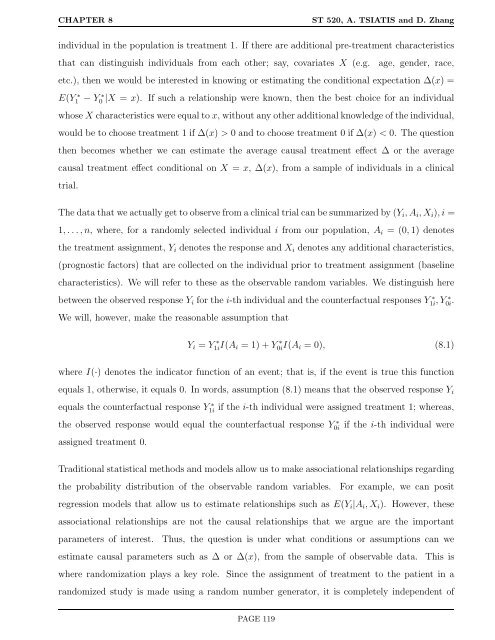ST 520 Statistical Principles of Clinical Trials - NCSU Statistics ...
ST 520 Statistical Principles of Clinical Trials - NCSU Statistics ...
ST 520 Statistical Principles of Clinical Trials - NCSU Statistics ...
Create successful ePaper yourself
Turn your PDF publications into a flip-book with our unique Google optimized e-Paper software.
CHAPTER 8 <strong>ST</strong> <strong>520</strong>, A. TSIATIS and D. Zhang<br />
individual in the population is treatment 1. If there are additional pre-treatment characteristics<br />
that can distinguish individuals from each other; say, covariates X (e.g. age, gender, race,<br />
etc.), then we would be interested in knowing or estimating the conditional expectation ∆(x) =<br />
E(Y ∗<br />
1<br />
∗ − Y0 |X = x). If such a relationship were known, then the best choice for an individual<br />
whose X characteristics were equal to x, without any other additional knowledge <strong>of</strong> the individual,<br />
would be to choose treatment 1 if ∆(x) > 0 and to choose treatment 0 if ∆(x) < 0. The question<br />
then becomes whether we can estimate the average causal treatment effect ∆ or the average<br />
causal treatment effect conditional on X = x, ∆(x), from a sample <strong>of</strong> individuals in a clinical<br />
trial.<br />
The data that we actually get to observe from a clinical trial can be summarized by (Yi, Ai, Xi), i =<br />
1, . . .,n, where, for a randomly selected individual i from our population, Ai = (0, 1) denotes<br />
the treatment assignment, Yi denotes the response and Xi denotes any additional characteristics,<br />
(prognostic factors) that are collected on the individual prior to treatment assignment (baseline<br />
characteristics). We will refer to these as the observable random variables. We distinguish here<br />
between the observed response Yi for the i-th individual and the counterfactual responses Y ∗ ∗<br />
1i , Y0i .<br />
We will, however, make the reasonable assumption that<br />
Yi = Y ∗<br />
1iI(Ai = 1) + Y ∗<br />
0iI(Ai = 0), (8.1)<br />
where I(·) denotes the indicator function <strong>of</strong> an event; that is, if the event is true this function<br />
equals 1, otherwise, it equals 0. In words, assumption (8.1) means that the observed response Yi<br />
equals the counterfactual response Y ∗<br />
1i if the i-th individual were assigned treatment 1; whereas,<br />
the observed response would equal the counterfactual response Y ∗<br />
0i if the i-th individual were<br />
assigned treatment 0.<br />
Traditional statistical methods and models allow us to make associational relationships regarding<br />
the probability distribution <strong>of</strong> the observable random variables. For example, we can posit<br />
regression models that allow us to estimate relationships such as E(Yi|Ai, Xi). However, these<br />
associational relationships are not the causal relationships that we argue are the important<br />
parameters <strong>of</strong> interest. Thus, the question is under what conditions or assumptions can we<br />
estimate causal parameters such as ∆ or ∆(x), from the sample <strong>of</strong> observable data. This is<br />
where randomization plays a key role. Since the assignment <strong>of</strong> treatment to the patient in a<br />
randomized study is made using a random number generator, it is completely independent <strong>of</strong><br />
PAGE 119
















